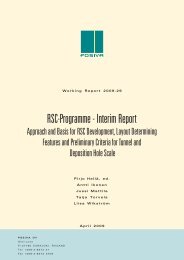Bentonite Mineralogy Part 1: Methods of Investigation - Posiva
Bentonite Mineralogy Part 1: Methods of Investigation - Posiva
Bentonite Mineralogy Part 1: Methods of Investigation - Posiva
Create successful ePaper yourself
Turn your PDF publications into a flip-book with our unique Google optimized e-Paper software.
17<br />
3.2 Differential thermal analysis {DTA)<br />
Differential thermal analysis is used for registration the temperatures <strong>of</strong> endothermic<br />
and exothermic reactions. It is <strong>of</strong>ten coupled with TGA, thermogravimetric analysis that<br />
registers changes in sample weight. The furnace heating rate can be chosen. Post and<br />
Borer (2002) used heating rate 7°C/min and noticed, that the endotherm temperature<br />
correlated with the interlayer cation <strong>of</strong> mixed-layer illite/beidellites and beidellites.<br />
DTA gives information about the thermal stability <strong>of</strong> clay minerals but effects <strong>of</strong> longterm<br />
exposition to elevated temperatures cannot be simulated. For instance hydration<br />
water is lost with heating to 11 0°C if the heating is prolonged over 24 hours. At normal<br />
heating rate in DT A, 1 0°C/min, some hydration water still exist in clay minerals heated<br />
to 300°C, even if most <strong>of</strong> it is lost below 200°C. Structural water is lost between 500<br />
and 700°C.<br />
The thermal stability <strong>of</strong> dioctahedral smectites consisting <strong>of</strong> cis-vacant 2:1 layers are<br />
characterized by dehydroxylation temperatures <strong>of</strong> 150-200°C higher than those for the<br />
same mineral consisting <strong>of</strong> trans-vacant 2:1 layers, ea 700°C vs ea 550°C, respectively<br />
(Drits et al., 1995). In case distinction between these two types is considered necessary,<br />
the use <strong>of</strong>DTA is recommended.<br />
Recommendation:<br />
Use <strong>of</strong> DT A/TGA is recommendable only if the distinction between cis- and transvacant<br />
varieties is considered as necessary.<br />
3.3 Fourier transform infrared spectroscopy {FTIR)<br />
Infrared spectroscopy is best suitable to investigation <strong>of</strong> compounds with simple<br />
chemical formula. Clay minerals are chemically related and IR spectra <strong>of</strong> a mixture <strong>of</strong><br />
them are difficult to interpret. <strong>Bentonite</strong>s are mineralogically simple, although<br />
chemically complicated, and FTIR can be used especially for comparing samples with<br />
each other. Because the amount <strong>of</strong> sample used for pressing the pellets is very small (1 -<br />
3 mg <strong>of</strong> sample/1 00 - 300 mg <strong>of</strong> KBr) clay fraction should be used. It also contains less<br />
detrital minerals like quartz and feldspars. If it is necessary to record the IR spectra <strong>of</strong><br />
bulk samples they have to be homogenized carefully. In a series <strong>of</strong> papers on bentonite<br />
mineralogy, no information is given on the fraction used for FTIR. Apparently, bulk<br />
material has been used. It is possible that some information can be obtained <strong>of</strong> the<br />
amorphous compounds present.<br />
Madejova & Komadel (2001) recommend the use <strong>of</strong> two different sample/KBr ratios for<br />
pressing the pellets: 2 mg <strong>of</strong> sample and 200 mg <strong>of</strong>KBr to record optimal spectra in the<br />
region <strong>of</strong> 4000-3000 cm- 1 and 0,5 mg <strong>of</strong> sample and 200 mg <strong>of</strong> KBr to record optimal<br />
spectra in the region 4000-400 cm- 1 • Discs for the 4000-3000 cm- 1 were heated<br />
overnight at 150°C to minimize the water absorbed on KBr and the clay sample. A list<br />
<strong>of</strong>iR-bands in two Wyoming bentonites are given in table 3-4.

















